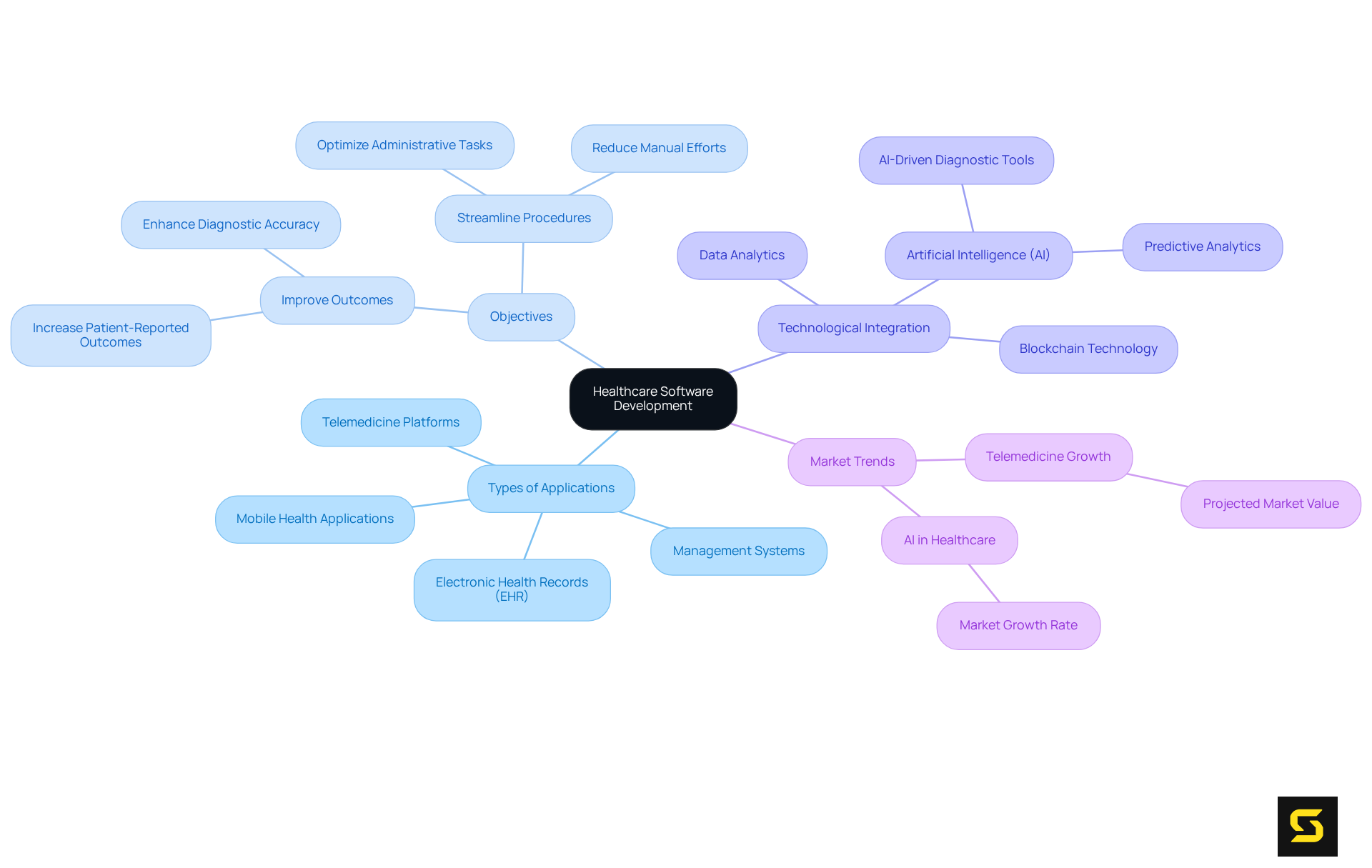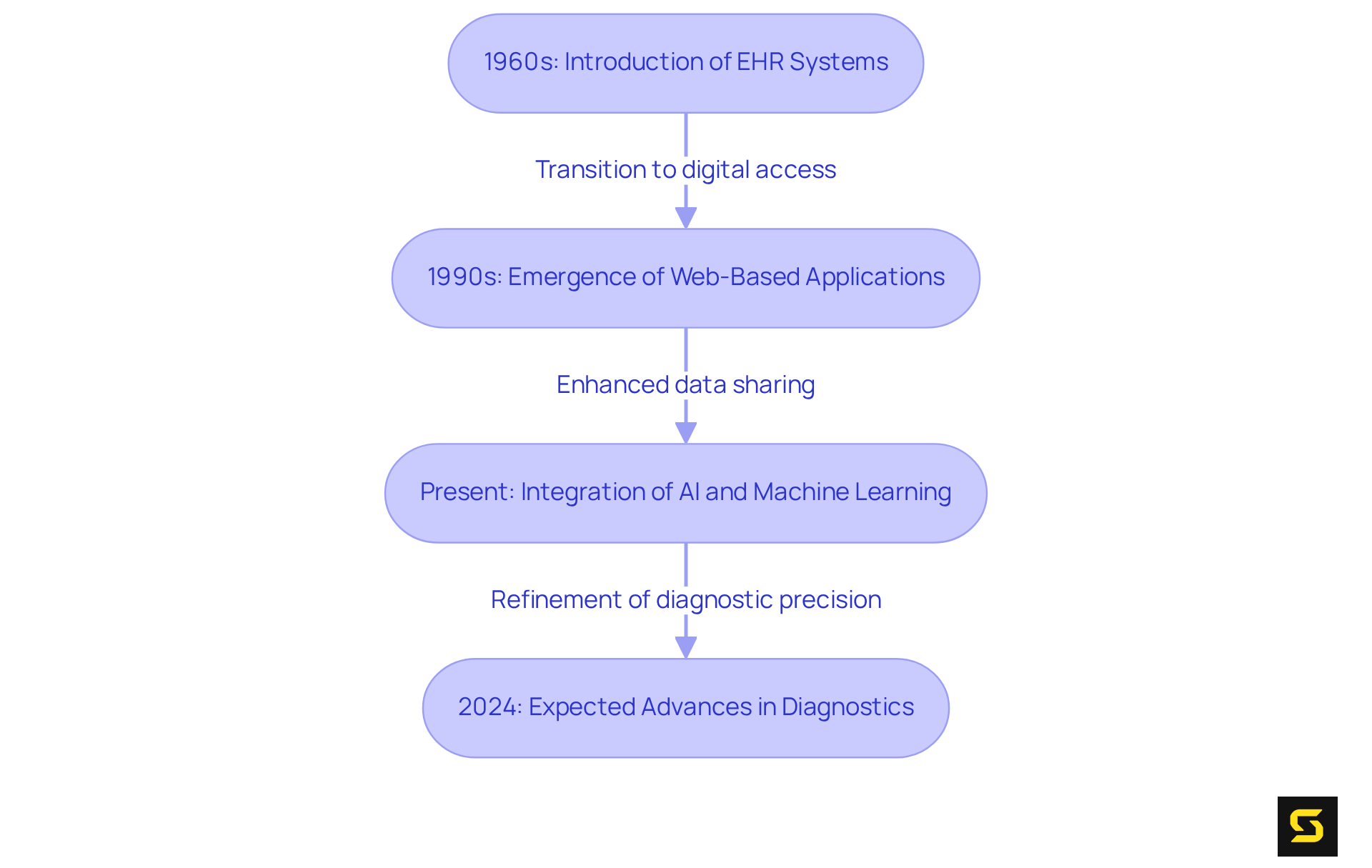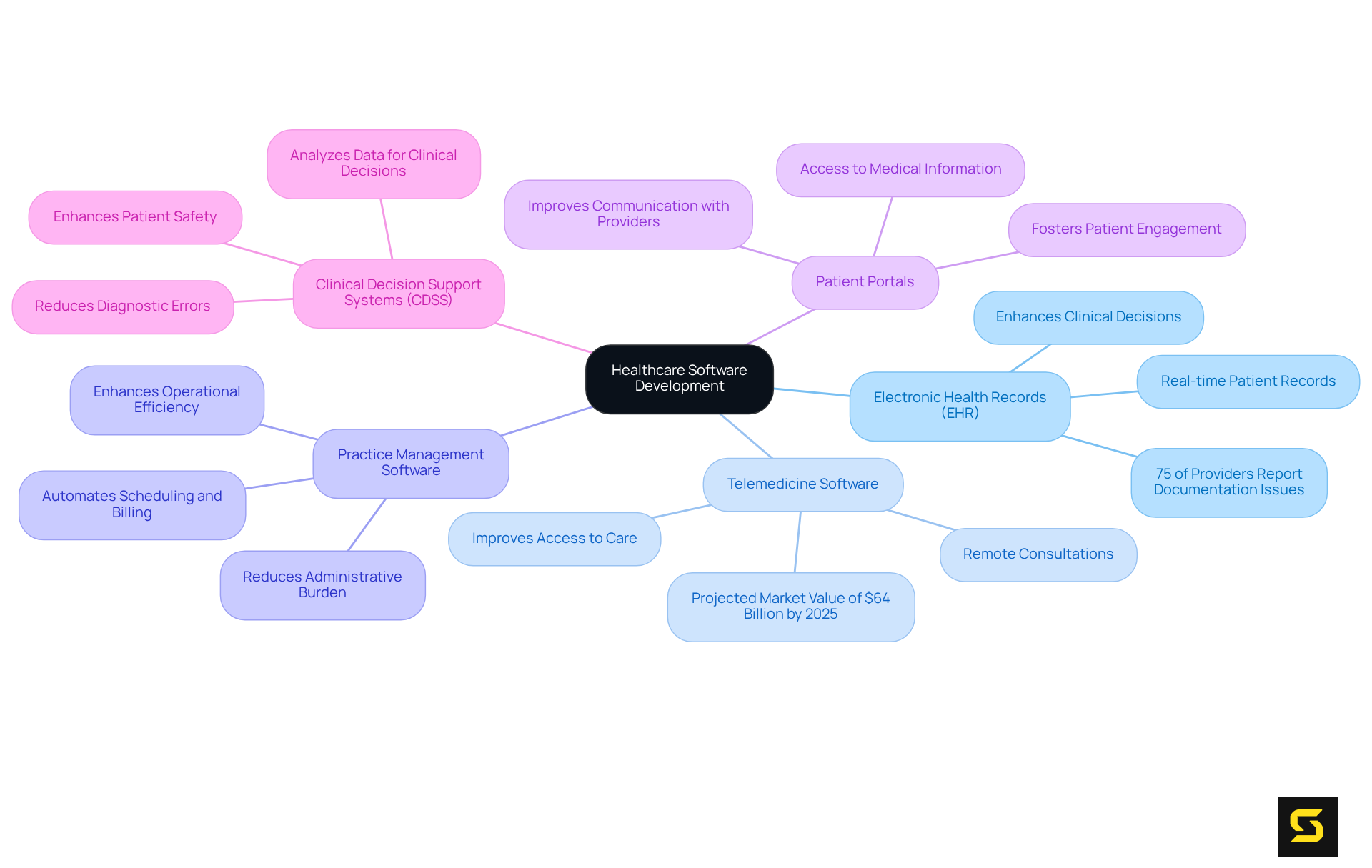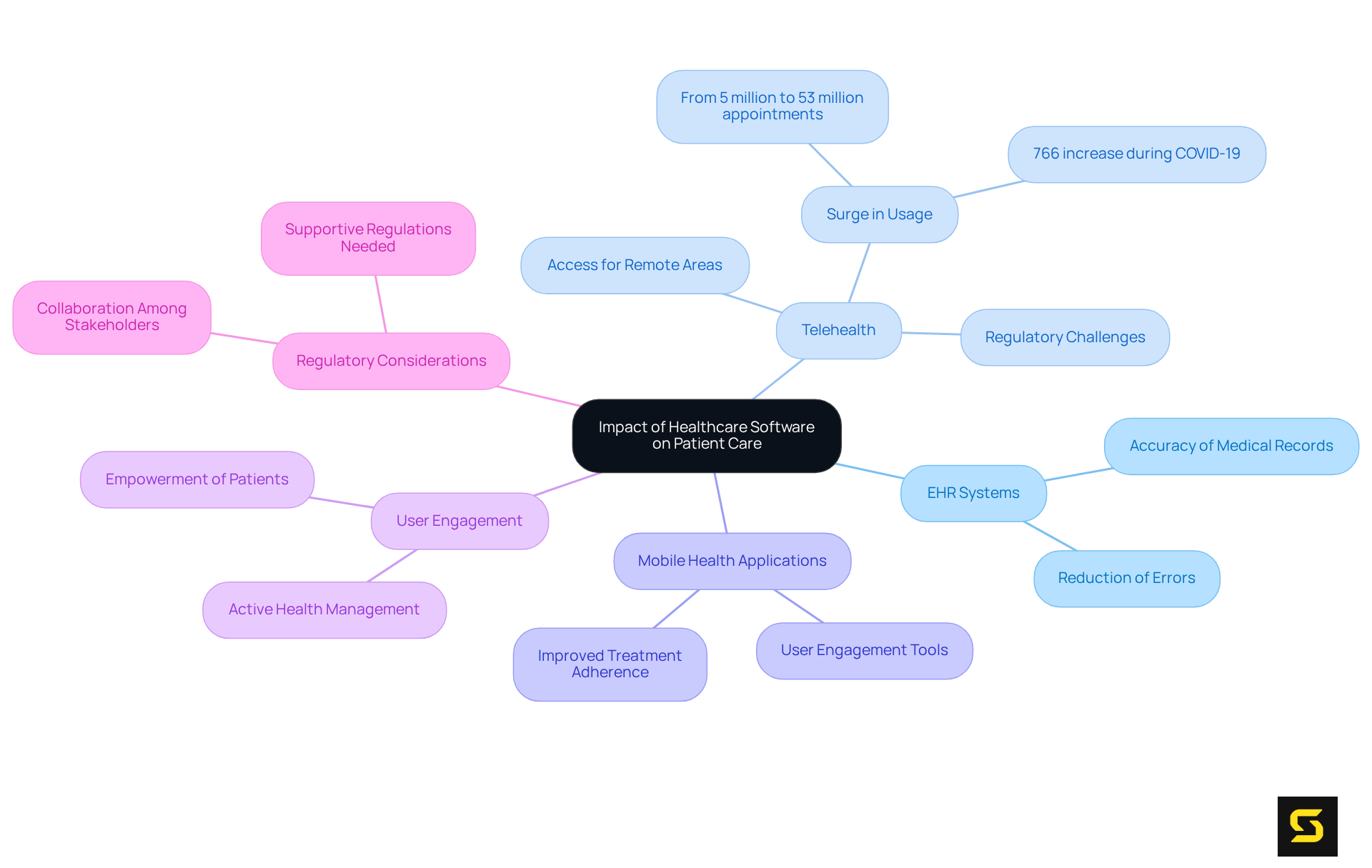Overview
Healthcare software development is essential for elevating medical services through customized applications, including electronic health records (EHR), telemedicine platforms, and management systems. These innovations significantly enhance service delivery and improve patient outcomes. Advanced technologies, such as artificial intelligence (AI) and data analytics, are revolutionizing healthcare practices. They enable personalized care and streamline operations, effectively addressing the evolving demands of both providers and patients. This transformation underscores the necessity for healthcare organizations to adopt tailored software solutions that not only enhance efficiency but also foster better patient engagement and satisfaction.
Introduction
The healthcare landscape is experiencing a transformative shift, propelled by the rapid evolution of software solutions tailored for the medical industry. As healthcare software development becomes increasingly essential, it presents SaaS owners with a unique opportunity to enhance service delivery, improve patient outcomes, and adeptly navigate the complexities of modern medical care. However, this progress brings forth the challenge of integrating advanced technologies while ensuring compliance and security.
What key insights must SaaS owners grasp to fully harness the potential of healthcare software development?
Define Healthcare Software Development
The process of healthcare software development is critical as it involves designing, creating, and maintaining applications specifically tailored for the medical industry. This encompasses a diverse range of solutions, including:
- electronic health records (EHR)
- telemedicine platforms
- management systems
- mobile health applications
The primary objective of healthcare software development is to enhance service delivery effectiveness, improve individual outcomes, and streamline administrative procedures. For instance, the implementation of a data tracking platform led to a remarkable 40% increase in patient-reported outcomes, underscoring the tangible benefits of efficient technological solutions.
By integrating advanced technologies such as artificial intelligence (AI) and data analytics, medical software can effectively tackle the specific challenges faced by providers and patients. AI-driven diagnostic tools, for example, analyze extensive medical data to identify patterns and anomalies, enabling early disease detection. The telemedicine market, projected to reach $160.13 billion by 2025, illustrates the increasing dependence on digital solutions to facilitate remote consultations and enhance access to care. As noted by SynergyTop, telemedicine is becoming the norm, with virtual visits and remote monitoring now integral to medical service delivery.
Effective applications, such as those found in digital mental wellness platforms, highlight the rising demand for accessible mental health support, further driving innovation in medical technology. Expert insights emphasize the significance of healthcare software development in elevating the quality of medical treatments. With 93% of medical providers acknowledging the in improving client outcomes, the sector is undergoing a transformation towards personalized and efficient care delivery. As medical care evolves, the role of customized technological solutions becomes increasingly vital in meeting the needs of both providers and patients.

Explore the Evolution and Context of Healthcare Software Development
The evolution of medical application development commenced in the 1960s with the introduction of the first electronic health record (EHR) systems, which primarily focused on administrative tasks. Over the decades, these systems have undergone significant transformations, propelled by technological advancements. The emergence of the internet in the 1990s marked a pivotal moment, facilitating the creation of web-based applications that enhanced accessibility and allowed for seamless data sharing among medical providers.
Today, healthcare software development stands at the forefront of innovation, characterized by the integration of (AI), machine learning, and big data analytics. These technologies not only enhance operational efficiency but also enable personalized medicine and predictive analytics—essential components for customizing treatments to meet individual patient needs. In 2024, AI and machine learning are expected to refine diagnostic precision and operational effectiveness, heralding a substantial shift in medical practices.
Statistics reveal a steady increase in the adoption of EHR systems, bolstered by legislation during the Obama administration mandating their implementation across all delivery settings, which significantly advanced healthcare software development. As medical services progressively transition towards value-driven care and patient-centered approaches, the demand for advanced healthcare software development solutions becomes increasingly critical. Organizations that embrace these innovations, including telehealth and remote monitoring, are strategically positioned to improve outcomes and maintain a competitive edge in the evolving medical landscape. Furthermore, as cybersecurity becomes paramount in protecting sensitive medical information, healthcare institutions must prioritize robust security protocols within their development processes.

Identify Key Characteristics and Types of Healthcare Software
Healthcare software development is categorized into several key types, each serving distinct purposes essential for modern medical practices. Among the most common types are:
- Electronic Health Records (EHR): These digital versions of patients' paper charts provide real-time, patient-centered records, making information instantly and securely available to authorized users. EHRs are crucial in enhancing outcomes for individuals by offering comprehensive data that aids clinical decisions. Notably, approximately 75% of healthcare providers report that documentation hinders treatment, underscoring the necessity for effective software solutions.
- Telemedicine Software: This category encompasses platforms that facilitate remote consultations between medical providers and individuals, ensuring access to care regardless of location. The telemedicine market is projected to reach a value of $64 billion by 2025, highlighting its growing significance in contemporary medical services.
- Practice Management Software: These tools assist medical providers in managing their daily operations, including scheduling, billing, and client communication. By automating these processes, practice management software alleviates administrative burdens and enhances operational efficiency.
- Patient Portals: Secure online platforms that grant individuals access to their medical information, allowing them to view test results, schedule appointments, and communicate with their medical providers. This transparency fosters between individuals receiving care and providers, ultimately enhancing engagement.
- Clinical Decision Support Systems (CDSS): This software analyzes data to assist medical professionals in making informed clinical decisions, thereby enhancing outcomes and minimizing errors. By offering evidence-based suggestions, CDSS improves safety for individuals and reduces diagnostic errors.
Each type of healthcare software development plays a vital role in enhancing efficiency and effectiveness within the healthcare system. As the sector evolves, the integration of cutting-edge technologies, including AI, continues to transform service delivery, ensuring providers can meet the increasing needs of those they serve. Furthermore, it is imperative to guarantee adherence to data security regulations (e.g., HIPAA, GDPR) to protect sensitive individual information.

Assess the Impact of Healthcare Software Development on Patient Care
The impact of medical application development on individual treatment is both significant and intricate. By streamlining administrative processes, healthcare software development alleviates the burden on providers, allowing them to focus more intently on patient care.
For instance, Electronic Health Record (EHR) systems enhance the accuracy of medical records, thereby diminishing the likelihood of errors that could lead to adverse outcomes. A striking statistic reveals that telehealth appointments among Medicare beneficiaries surged from 5 million to over 53 million during the COVID-19 pandemic, underscoring the effectiveness of telemedicine in expanding access to services, particularly for those in remote areas.
Telemedicine platforms facilitate timely consultations and follow-ups, bridging geographical divides and ensuring that individuals receive necessary support without the encumbrance of travel. Furthermore, user engagement tools, such as mobile health applications, empower individuals to actively manage their health, resulting in improved adherence to treatment plans and better health outcomes.
However, the successful integration of telemedicine necessitates supportive regulations and collaboration among stakeholders to tackle adoption challenges. Additionally, while telemedicine enhances access, the financial implications—such as the costs associated with implementing telemedicine technology in rural hospitals—must be carefully considered.
Ultimately, the integration of not only boosts operational efficiency but also significantly elevates the quality of care provided to patients, establishing it as an essential element of contemporary healthcare delivery.

Conclusion
Healthcare software development stands as a cornerstone of modern medical practice, providing essential tools that enhance service delivery and improve patient outcomes. The integration of innovative technologies, including AI, telemedicine, and data analytics, is transforming the healthcare landscape, enabling providers to offer more personalized and efficient care. As the medical field evolves, the significance of tailored software solutions in addressing the unique challenges faced by both providers and patients becomes increasingly critical.
Key insights reveal various types of healthcare software, such as:
- Electronic Health Records (EHR)
- Telemedicine platforms
- Clinical decision support systems
Each playing a crucial role in modern healthcare delivery. The evolution of these technologies, from their inception in the 1960s to the sophisticated solutions available today, highlights the ongoing transformation within the industry. Moreover, the substantial impact of healthcare software on patient care—particularly through enhanced accessibility and operational efficiency—underscores the necessity for continued innovation in this field.
As the healthcare sector advances, embracing software development advancements will be vital for organizations seeking to improve patient care and maintain a competitive edge. Stakeholders must prioritize investment in robust healthcare software solutions while addressing challenges such as data security and regulatory compliance. By doing so, they can ensure that the benefits of technology are fully realized, paving the way for a future where healthcare is more accessible, efficient, and patient-centered.
Frequently Asked Questions
What is healthcare software development?
Healthcare software development is the process of designing, creating, and maintaining applications specifically tailored for the medical industry, including solutions like electronic health records (EHR), telemedicine platforms, management systems, and mobile health applications.
What is the primary objective of healthcare software development?
The primary objective is to enhance service delivery effectiveness, improve individual outcomes, and streamline administrative procedures in the medical field.
Can you provide an example of the benefits of healthcare software?
An example is the implementation of a data tracking platform that led to a 40% increase in patient-reported outcomes, demonstrating the tangible benefits of efficient technological solutions.
How do advanced technologies like AI impact healthcare software?
Advanced technologies such as artificial intelligence (AI) and data analytics help tackle specific challenges faced by providers and patients, enabling tools like AI-driven diagnostics to analyze medical data for early disease detection.
What is the projected growth of the telemedicine market?
The telemedicine market is projected to reach $160.13 billion by 2025, indicating a growing dependence on digital solutions for remote consultations and enhanced access to care.
What role does telemedicine play in modern healthcare?
Telemedicine is becoming the norm in medical service delivery, with virtual visits and remote monitoring now integral to providing care.
Why is there a rising demand for mental health support in healthcare software?
The demand for accessible mental health support is increasing, driving innovation in medical technology, as seen in digital mental wellness platforms.
How do medical providers view the impact of technology on client outcomes?
According to expert insights, 93% of medical providers acknowledge the advantages of technology in improving client outcomes, indicating a transformation towards personalized and efficient care delivery.
Why are customized technological solutions important in healthcare?
Customized technological solutions are vital in meeting the evolving needs of both providers and patients as medical care continues to develop.





